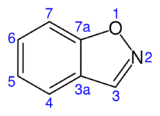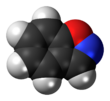Chemistry:Benzisoxazole

| |||
| |||
| Names | |||
|---|---|---|---|
| Preferred IUPAC name
1,2-Benzoxazole | |||
| Other names
Benzo[d]isoxazole; Indoxazine
| |||
| Identifiers | |||
3D model (JSmol)
|
|||
| 2154 | |||
| ChEBI | |||
| ChEMBL | |||
| ChemSpider | |||
| EC Number |
| ||
PubChem CID
|
|||
| UNII | |||
| |||
| |||
| Properties | |||
| C7H5NO | |||
| Molar mass | 119.123 g·mol−1 | ||
| Appearance | Colorless liquid | ||
| Density | 1.18 g/cm3 | ||
| Boiling point | 35 to 38 °C (95 to 100 °F; 308 to 311 K) (at 2.67 hPa) 101-102 °C (at 2 kPa) | ||
| Hazards | |||
| GHS pictograms | 
| ||
| GHS Signal word | Warning | ||
| H315, H319, H335 | |||
| P261, P264, P271, P280, P302+352, P304+340, P305+351+338, P312, P321, P332+313, P337+313, P362, P403+233, P405, P501 | |||
| Flash point | 58 °C (136 °F; 331 K) | ||
Except where otherwise noted, data are given for materials in their standard state (at 25 °C [77 °F], 100 kPa). | |||
| Infobox references | |||
1,2-Benzisoxazole is an aromatic organic compound with a molecular formula C7H5NO containing a benzene-fused isoxazole ring structure.[1][2] The compound itself has no common applications; however, functionalized benzisoxazoles and benzisoxazoyls have a variety of uses, including pharmaceutical drugs such as some antipsychotics (including risperidone, paliperidone, ocaperidone, and iloperidone) and the anticonvulsant zonisamide.
Its aromaticity makes it relatively stable;[3] however, it is only weakly basic.
Synthesis
Benzisoxazole may be prepared from inexpensive salicylaldehyde, via a base catalyzed room temperature reaction with hydroxylamine-O-sulfonic acid.[4]
Reactions
Kemp elimination
First reported by Daniel S. Kemp,[5][6][7] the relatively weak N-O bond can be cleaved by a strong base to yield a 2-hydroxybenzonitrile species.
See also
- Structural isomers
References
- ↑ Template:Katritzky2nd
- ↑ Clayden, J.; Greeves, N.; Warren, S.; Wothers, P. (2001). Organic Chemistry. Oxford, Oxfordshire: Oxford University Press. ISBN 0-19-850346-6. https://archive.org/details/organicchemistry00clay_0.
- ↑ Domene, Carmen; Jenneskens, Leonardus W.; Fowler, Patrick W. (2005). "Aromaticity of anthranil and its isomers, 1,2-benzisoxazole and benzoxazole". Tetrahedron Letters 46 (23): 4077–4080. doi:10.1016/j.tetlet.2005.04.014. ISSN 0040-4039.
- ↑ Kemp, D.S.; Woodward, R.B. (1965). "The N-ethylbenzisoxazolium cation—I". Tetrahedron 21 (11): 3019–3035. doi:10.1016/S0040-4020(01)96921-2. ISSN 0040-4020.
- ↑ Casey, Martha L.; Kemp, D. S.; Paul, Kenneth G.; Cox, Daniel D. (June 1973). "Physical organic chemistry of benzisoxazoles. I. Mechanism of the base-catalyzed decomposition of benzisoxazoles". The Journal of Organic Chemistry 38 (13): 2294–2301. doi:10.1021/jo00953a006.
- ↑ Kemp, D. S.; Cox, Daniel D.; Paul, Kenneth G. (December 1975). "Physical organic chemistry of benzisoxazoles. IV. Origins and catalytic nature of the solvent rate acceleration for the decarboxylation of 3-carboxybenzisoxazoles". Journal of the American Chemical Society 97 (25): 7312–7318. doi:10.1021/ja00858a018.
- ↑ Kemp, Daniel S. (April 1970). "Decarboxylation of benzisoxazole-3-carboxylic acids. Catalysis by extraction of possible relevance to the problem of enzymic mechanism". Journal of the American Chemical Society 92 (8): 2553–2554. doi:10.1021/ja00711a061.
 |





